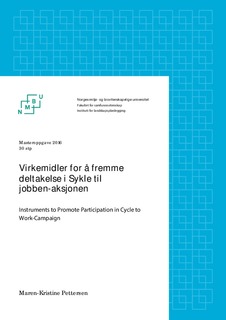| dc.contributor.advisor | Stefansdottir, Harpa | |
| dc.contributor.author | Pettersen, Maren-Kristine | |
| dc.date.accessioned | 2016-08-24T13:05:02Z | |
| dc.date.available | 2016-08-24T13:05:02Z | |
| dc.date.issued | 2016-08-24 | |
| dc.identifier.uri | http://hdl.handle.net/11250/2401487 | |
| dc.description.abstract | Hovedmålet med oppgaven var å finne virkemidler som kan fremme deltakelsen i Sykle til jobben –aksjonen blant ansatte som ikke deltar. Ved å undersøke hvilke barrierer og forutsetninger som påvirker deltakelsen på makro-, meso- og mikronivå, ble flere virkemidler utviklet under ulike virkemiddelkategorier, og på de tre nivåene. Et casestudiet av ansatte som ikke deltar i Sykle til jobben –aksjonen er gjennomført. Kvalitative intervju med tre ulike målgrupper er grunnlaget for analysene. Sosiale-kognitive teori, Sosial praksisteori og det sosio-økologiske perspektiv er brukt både i utvalg av undersøkelsesfaktorer, i analysen og drøftingen av resultatene. Analysen fulgte en tre-stegs-innholdsanalyse; beskrive, systematisere og kategorisere, og sammenbinde. For å sammenbinde ble metoden «Experience near – experience distant» brukt (Jacobsen, 2005). Sammenbindingen hjalp utviklingen virkemidlene.
En egen kvantitativ kartleggingsdel tidlig i oppgaven, viser en skjev fordeling i deltakelse etter utdanningsnivå. Av forskningsetiske grunner ble ikke ansatte med lav sosioøkonomisk status undersøkt spesifikt, men utvalget ble tilfeldig ut ifra utdanningsnivå.
Resultatene viser at samspillet av barrierer og forutsetninger på de ulike nivåene krever et bredt spekter av tiltak og virkemidler, for å fremme deltakelsen blant ansatte som ikke deltar. Hovedtiltakene som kan iverksettes for å fremme deltakelsen blir under fysiske og strukturelle virkemidler omtalt som «Å dekke grunnleggende fysiske og materielle behov», grunnleggende behov iverksatt på makro- og mesonivå. Av informative og kommunikative virkemiddel kan det på mesonivå iverksettes tiltak om «Informerende, enkel og visualiserende markedsføring», samtidig som rekrutteringen bør foregå mer gjennom fysisk tilstedeværelse i bedriften og gjennom mellommenneskelig metoder, samt på ulike språk. Som økonomisk virkemiddel kan et tiltak på makronivå som «Tilskudd fra staten» både redusere barrierer i Bedriftsidretten og for arbeidsplassen. Undersøkelsene gav få funn innen regulative virkemidler, samtidig kan det vurderes «Reguleringer for å fremme Norges sykkelkultur», det kan handle om regulering på makronivå. Det ble formet to hovedtiltak under kulturelle og sosiale virkemidler, det første er «Lokale pushere og ildsjeler» på mesonivå, som kan sikre ansatte sosial tilhørighet og lagdeltakelse. Det andre handler om å «Bygge realistiske image», finne positive image som favner det brede aktivitetsnivået blant ansatte. Både for spreke og mindre spreke. | nb_NO |
| dc.description.abstract | The main purpose of this thesis was to find instruments, which can promote the participation in «Sykle til jobben» (e. cycling to work) –campaign among employees that does not participate. By investigating different barriers and assumptions, which affects the participation on both macro-, meso- and micro level, several instruments where developed under different categories, and under those three levels. One case study of the employees that do not participate in campaign where done. Qualitative interviews from three different groups are the foundation of the analysis. In the selection of the factors for investigation both Social-cognitive theory, Social practice theory and Socioecological perspectives where used in the analysis and discussion. The analysis followed a three-step content analysis: describe, systemize and categorize and connect. The method “Experience near – experience distant” where used to connect and it helped in developing the different instruments and intiatives (Jacobsen, 2005).
Early in the thesis, an separate quantative mapping shows an unequal distribution of participation by level of education. Because of ethics in research, employees where not chosen after socioeconomic status specifically. The sample where randomly distributed independently on level of education.
The results show that the interplay between barriers and assumptions on the different levels demands a wide spectre of intiatives and instruments. This in order to promote the participation among employees that does not participate. The main initiatives that can be implements in order to promote participation under physical and structural measures are referred to as “To cover fundamental physical and material needs”. These are fundamental needs implemented on macro- and meso level. On meso level there can be initiated informative and communicative instruments about “Informing, simple and visualizing marketing”. At the same time, the recruitment should be done by physical presence at the workplace, and through interpersonal methods and in different languages. As an economical instrument, can intiatives on macro level reduce barriers between “Bedriftsidretten” and the workplace by receiving Government subsidizes. The research showed few findings concerning regulative instruments. At the same time one should consider “Regulations to promote Norwegian biking culture”. This could contain regulations on macro level. There was formed two main initiatives under cultural and social instruments. The first where, “Local pushers and enthusiasts” on meso level. These could ensure employees social acceptance and team participation. The second speaks of “Building a realistic image”, finding positive images which contains the wide activity level among employees. Both active and inactive. | nb_NO |
| dc.language.iso | nob | nb_NO |
| dc.publisher | Norwegian University of Life Sciences, Ås | |
| dc.subject | Virkemidler | nb_NO |
| dc.subject | Sykling | nb_NO |
| dc.subject | Ansatte | nb_NO |
| dc.title | Virkemidler for å fremme deltakelsen i Sykle til jobben -aksjonen | nb_NO |
| dc.title.alternative | Instruments to Promote Participation in Cycle to Work Campaign | nb_NO |
| dc.type | Master thesis | nb_NO |
| dc.subject.nsi | VDP::Social science: 200 | nb_NO |
| dc.source.pagenumber | 94 | nb_NO |
| dc.description.localcode | M-FOL | nb_NO |
